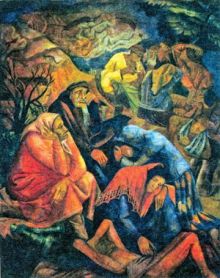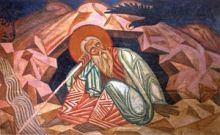“When the winter is over, and the first flowers appear in early spring, they are few, but we know that the spring will come, and there will be thousands of flowers.” This was one of the exhortations given by the Ukrainian Monumentalist painter Mykhailo Boichuk to his pupils. In 1917, he created an original school of Ukrainian Monumentalism. Boichuk’s school existed for only 20 years, uniting nearly 40 disciples, yet the trend in art founded by him has become a global artistic and cultural phenomenon.
In Paris, where Boichuk and his followers first made themselves known, they were dubbed neo-Byzantines. Boichuk in fact aspired to revive Byzantine art, since in it he saw the roots of national Ukrainian art. However, at the same time he would say to his pupils, “We are only as much a school of Byzantine renaissance as much our culture has been influenced by it. ‘Neo-Byzantine’ is just a term facilitating comprehension. At home, we will adopt a different name!”
Indeed, in Ukraine this trend in art was dubbed “Boichukism,” after the name of its founder, while Boichuk himself would call his creature Ukrainian monumentalism. Boichuk’s Monumentalism, with his icons and frescoes for big buildings, reminded one of Italian Quattrocento art. Together with his pupils, he worked to create a new artistic style, synthetic and monumental, and at the same time rooted in the national cultural traditions.
Although Boichukist art was mostly a quintessence of the Ukrainian fine arts, some of his followers also turned to other cultural sources. Among them was Manuil Shekhtman. In Shekhtman’s art, Boichukist Monumentalism was realized on the ground of Jewish, rather than Ukrainian, national traditions. Shekhtman was Jewish, so no wonder that he added something of his own to the artistic trend of his teacher.
On the other hand, the presence among Boichuk’s followers of people of various nationalities and social backgrounds is yet another proof to the fact that Boichukist Monumental painting has risen to an international level. Yaroslav Kravchenko, in his sizeable research titled Mykhailo Boichuk’s School: 37 Names (Oranta Publishers, 2010), describes in detail the work of Shekhtman and Boichuk’s other followers.
Shekhtman, born near Zhytomyr, came to Boichuk’s studio at the age of 20, and immediately joined the creative group of artists enamored with their teacher. After seeing the Fall exhibit of the Ukrainian Academy of Arts, Lev Dintses, an art critic from Kyiv, said this of Shekhtman: “There is another interesting Boichuk pupil. M. Shekhtman is Jewish, and it is the national coloring of his relatively young works that makes him stand out at the exhibit. Drawing on ancient oriental reliefs, on the one hand, and Jewish baroque, on the other, he merges these essentially alien elements in an original way, so typical of the local Jewish altars.”
Five years later, after seeing the first Ukrainian-wide ARMU [Revolutionary Association of Ukrainian Art – Ed.] exhibit in Kharkiv, where Shekhtman displayed his paintings After the Pogrom and Mother, art critic Ivan Vrona wrote: “Shekhtman’s works are fragments of one poem, one terrible national epopee of the Jewish people.” Next year, Shekhtman executed his Migrants. This painting shows the drama of a Jewish family forced to move from their long-time home to a “promised land.”
Meanwhile, Shekhtman also drew on Ukrainian motifs. During the painting of the Peasants Sanatorium in Odesa in 1928, the artist created a mural dedicated to the past of the Ukrainian countryside. A placid, idyllic scene of a landowner’s family riding with greyhounds against a background of hills and the stone walls of a monastery contrasts sharply with a scene depicting a steward of the manor humiliating a peasant who is cutting wood.
After the completion of the painting of the sanatorium, Shekhtman worked as a director of the arts department of the Ukrainian-wide Museum of Jewish Culture, actively participated in exhibits of Soviet art in Kharkiv, Moscow, Zurich, and Tokyo. However, soon the persecutions of Boichukist painters began, after they were accused of nationalism, Shekhtman’s works started to get a lot of bitter censure. After the Pogrom was shown as an example of art hostile to the Soviet ideology. In 1937, this canvas was put on a list of 29 works by “enemies of the people,” withdrawn from the State Ukrainian Museum, which were to be destroyed. Miraculously, the painting survived.
Due to ideological persecution, Shekhtman had to move to Moscow as early as in 1934, where he worked as set designer for the State Jewish Theater. The painter died near Moscow at the very beginning of the Second World Two under unknown circumstances.
Despite the different national roots, training at Boichuk’s studio shaped Shekhtman’s artistic style. Art critic Liudmyla Sokoliuk maintains that “it is Boichukism that has become that foothold for Shekhtman which allowed him to solve problems related to the development of Jewish national art.”
The images are taken from Yaroslav Kravchenko’s book Mykhailo Boichuk’s School. 37 Names (Oranta Publishers)









